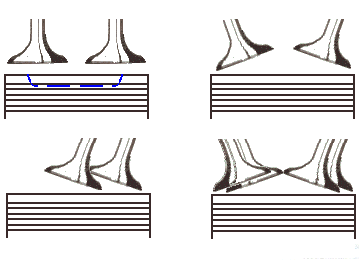
Assignment
The shape of the combustion chamber is very important for the mixture formation and the combustion. Ideally, it would be spherically shaped with the spark plug in the center, from where the core of the flame would spread
out evenly in all directions.
Function
In the case of the Heron combustion chamber, the chamber is, in relation to the completely flat cylinder head, slightly sunken
into the piston, here indicated in blue. Whereby, the edges of the piston can reach within less then 1 millimeter from the cylinder head, to achieve a swirling effect. The operation of either an overhead cam or one with
pushrods and rocker arms is possible. The OHV (push rod) engine, seldom found in motor cars nowadays, mostly has the second, roof shaped combustion chamber. It is operated by push rods and rocker arms.
The third, and particularly the fourth combustion chamber shapes are far more up-to-date (see above). Two valves in a roof-shaped arrangement were, for many years, the state-of-the-art. Especially sports-car engines
were fitted with them. In this case, larger valve diameters, in contrast to flat cylinder heads, are possible. Four-valve engines, are nearly always combined with two overhead cams (DOHC).
This shape comes pretty close to the ideal, however, when no valve lies parallel to the other, a more complicated control is also required. 10/11